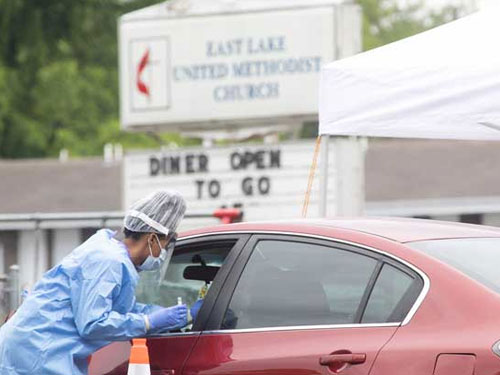The COVID-19 pandemic has brought many concerns regarding health disparities to light.
 In the initial stages of the COVID-19 pandemic in Alabama, people were examined for several viruses before being tested for the novel coronavirus. This process required multiple visits to the doctor and, in many cases, a primary care physician.
In the initial stages of the COVID-19 pandemic in Alabama, people were examined for several viruses before being tested for the novel coronavirus. This process required multiple visits to the doctor and, in many cases, a primary care physician.
Since COVID-19’s first confirmed case in Alabama, the CDC has recommended people take precautionary measures and practice social distancing. However, this practice, in dense under-resourced communities can prove difficult. Unlike high-income earners, low-income earners rarely receive paid-time-off, sick leave, the ability to work from home or telecommute, and the privilege of a flexible schedule.
In the service sector, employees must show up to work in order to get paid. This experience is true for food industry employees, sanitation workers, airport employees, and parking lot attendants (just to name a few). For low-income service workers, this means having to choose between losing their jobs or exposing themselves and their family to the risk of contracting COVID-19. Without a job, the lack of health insurance and high-deductible health care plans becomes an immediate deterrent for an individual with symptoms needing medical assistance. Fearful of the unknown medical bills, many people who find themselves in this position don’t seek help.
On March 23, UAB established its downtown drive-through testing site on University Boulevard, near campus as well as the South Town public housing community. In other parts of town, for-profit companies began drive-through testing at convenient locations in and around the city, many of them near high-income communities. This approach alienated many Birmingham residents who didn’t have access to a car or couldn’t afford to pay out-of-pocket prices for testing. Through decades of research, interventions, and working side-by-side with community partners, Live HealthSmart Alabama (LHSA) and UAB Minority Health & Health Disparities Research Center (MHRC) found itself in a unique position to act.
So, the question arose, “How do we make testing more accessible?”
Live HealthSmart Alabama, a program of the MHRC, strives to transform the health of Alabamians through changes to policies, systems, and built environments—through access to better nutrition, physical activity, and prevention and wellness. As COVID-19 spread across Alabama, it became evident that the people disproportionately affected by the virus, (many of whom were African American) were also the ones with underlying health conditions. This spurred the MHRC and Live HealthSmart Alabama to take action and provide access to testing in minority communities.
As an addition to the services Live HealthSmart Alabama offers the community, a plan to expand the model of UAB’s downtown testing facility to areas such as West Birmingham, Center Point, East Lake, Kingston, and Titusville, began to form in late-March. Throughout April, Live HealthSmart Alabama, the MHRC, UAB Medicine, and the Jefferson County Department of Health worked together to strategically select neighborhoods with the greatest chance of making accessible testing for everyone a reality.
To promote the initiative, Live HealthSmart Alabama created assets specifically for its target audience. Since much of the information being disseminated to the public was filled with difficult-to-understand medical jargon, team members took a step back and simplified the messaging. Once the messaging was finalized, MHRC community engagement teams placed COVID-19 tips and testing information throughout the designated neighborhoods. Meeting communities where they were, the main method of communication was yard signs, flyers, radio, and word-of-mouth via community leaders.
By late-April, calls were coming into a dedicated call center requesting an appointment—the first week booked full at over 100 tests. Once a patient’s voicemail is received, they are called on by culturally-appropriate, trained MHRC and LHSA Navigators who have a longstanding relationship with the MHRC and its programs. These Navigators play a critical role in helping Live HealthSmart Alabama address the myths, misconceptions, and fears these communities have toward testing and COVID-19.
Ready to make an impact, the MHRC and LHSA’s testing sites launched on April 30, the first anniversary of the announcement that the MHRC was named the recipient of the inaugural Grand Challenge. Since the initial planning stage, all the way up to the day of testing, community partners have worked with the MHRC and LHSA to bring testing and better health to their communities. To date, drive-thru and/or walk-up testing has occurred in Central Park, near Bush Hills, Kingston, Center Point, East Lake, West Birmingham, Fairfield, and Titusville.
For the residents of Titusville, the first community in the Birmingham area that former slaves were allowed to own property and one of the Live HealthSmart Alabama demonstration zones, the realities of low-income living are no different. Bishop Demetricus Roscoe from the Living Church Ministries reflects on growing up in the community and explains, “they [community members] were placed in apartments where they were afraid to go out their door… so it’s almost like you’re stuck in a place and forgotten.”
By bringing testing to places like Titusville, Bishop Roscoe is confident in the positive message this sends the community, “You are not forgotten. We know who you are.” Roscoe adds, “even if we don’t find anybody with the virus, we’ve done a service where the community feels like they haven’t been walked away from—it’s bigger than just testing.”